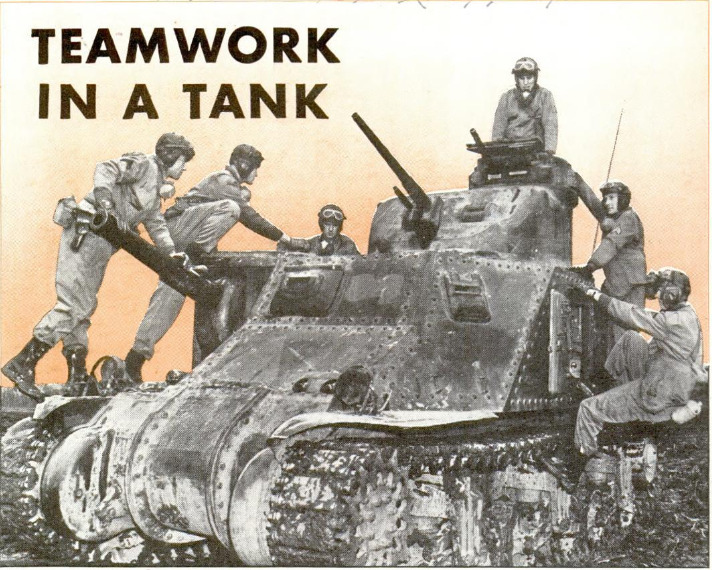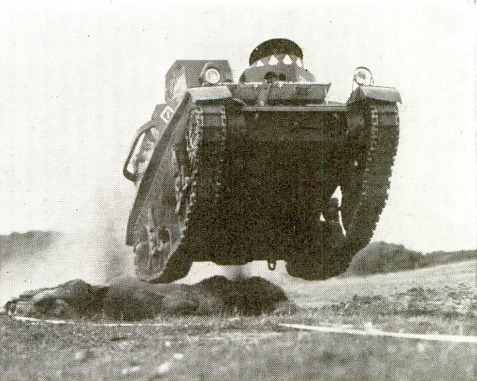EVERY time an M-3 medium tank bounces its 28 tons off some assembly line the Armored Force is faced with the job of training six men to man this $35,000 rolling fortress. At Fort Knox, Ky., home and nerve center of the Armored Force, the army has spent millions of dollars erecting and equipping a modern “blitz” college known as the Armored Force School. Here, in this unique training center, the six-man crews learn about tanks - and teamwork. From the time they report as rookies to the Ft. Knox Replacement Training Center, the men who are finally chosen as members of a tank crew are constantly exposed to the fundamentals on which the fast-moving, hard-hitting Armored Force is based. Let’s take a look at a typical crew, one of the crack tank teams in the 1st Armored Division (known as “Old Ironsides”) which was the first “panzer” unit organized by Uncle Sam. Sergeant Glenn E. Hinzman, from Dailey, W. Va, is a strapping 6-foot 2-inch 180-pounder. Tank operation is no mystery to him. He used to run a Caterpillar Diesel on big construction jobs. He's the tank commander. Technician 4th Class James H. Bowser (known to his buddies as “Bow Wow”) is the regular driver. He weighs 189 pounds, hails from Jasper, Ala., and has been around tanks for four years. The big 75-mm. cannon, which has a surprisingly small amount of recoil, is ably handled by Corporal Ellis Lott, who weighs 186 and comes from Rosedale, Miss. He was a tractor mechanic before his induction. Technician 5th Class Arnold F. Mees is the 37-mm. gunner. This heavyweight - 185 pounds - was formerly an automobile mechanic in Jansen, Nebr. Assisting him is Technician 5th Class Albert I Hess, Plymouth, Utah, who tips the scales at 175. He ran a tractor on a farm before joining the army. Sixth member of the crew is Private First Class William T. Daniels of Irvin, Ky., who handles the radio set. Smallest member of the crew, he weighs 176 pounds and is 5 feet 10 inches tall. Ages of the crew range from 22 to 25. Tank crews must be big, tough and cool headed. The men are as hardened as any football team and work as smoothly in the cramped quarters of a tank as a Stanford backfield from a “T” formation. It's “teamwork” that counts! No one man stars at any one job on this team. If tractors, most of them were familiar with the operation of the tracks which give a tank its advantages on rough terrain. Specialized courses began when they were transferred to the mammoth 314-building Armored Force School, headed by Brig. Gen. Stephen G. Henry, which turns out 22,000 technicians and 1,440 officers annually. In the tank department they learn, step by step, through the use of ingenious charts, models, and actual parts, the advantages and limitations of a tank. Each man studies the Diesel or Wright Whirlwind gasoline motor, takes it apart in the “dead engine” division, puts it back together, and learns the theory on which it operates. The transmission of power from the engine to the tracks and the electrical system are studied in separate divisions, each of which are 8-day courses. Finally, the crew members are taken into the “live engine” test building. The instructor sets up motor troubles and the student must diagnose them successfully. If he doesn’t make the grade, he fails to graduate as a qualified mechanic and is permitted to take the course over again. Since the tank course is run in sections, a man may repeat any one part of the course without disrupting his schedule. This “assembly-line” method trains more men than would be possible under usual conditions in civilian schools. The 14-week communications course encompasses the International Morse code and the various standard types of army radio sets. Every tank has a radio set and everyone in the crew is expected to be able to operate it in case the regular operator is injured. The operator must be able to receive 16 words per minute and send 12. If he can do better than this he is termed a “hot shot.” In the field, he sends messages from moving vehicles, tunes up his set, contacts the other stations in his “net” and makes repairs when necessary. The operator has channels to the company and battalion commanders, and can both receive and send messages. Some tanks have only one-way communication, but the M-3 medium usually has a two-way set. The six-week gunnery course includes the study of small arms, machine guns, the 37-mm. and 75-mm. cannons, and the Thompson submachine gun. All of the crew carry .45 revolvers. The tank has a 75-mm. cannon, a 37-mm. cannon, four 30-caliber machine guns, and “Tommy Gun.” During the first part of the course, students learn the parts and nomenclature of the various guns, and test their marksmanship on the electric-eye guns. Next step is firing on the 1,000-inch range from a “wobble plate,” an ingenious mechanism which simulates a moving tank in action. The final weeks are spent firing on the range from both stationary and moving tanks. At times sub-caliber shells are used (37-mm. bored to shoot a 22 short) to save money. On the range, the regular caliber shells are used. After completing this thorough training, the men are ready to get the feel of their tank, learn what it will do under certain conditions, and adapt themselves to unforeseen situations. Although each member of this crack six-man crew is a specialist in his own right, the beauty of the combination is the efficient manner in which they can shift positions and keep the tank operating effectively without lost motion. On road marches, maneuver problems and in combat, the job of driving is generally rotated so as not to decrease the efficiency rating through fatigue of any one member. During the intensive maneuver problems in the war games of the Carolinas and Louisiana, this sextet was constantly swapping seats in order to remain fresh and learn everything possible about all the tank operations. When it is revealed that tank crews in some cases were kept moving almost constantly for 60 hours on maneuvers, catching only occasional cat-naps, the value of rotating positions is readily apparent. You'd think “Bow Wow” Bowser would have his hands full just knowing how to drive the medium monster and keeping the enemy on the run firing the dual set of 30-caliber machine guns sputtering in front of him. But he’s also an accomplished handler of both the 75 and 37-mm. cannon and adept at taking over the radio position. Likewise, Sergeant Hinzman can come down from his turret position where he mans the 30-caliber antiaircraft machine gun in addition to directing the operation of his rolling fortress and take over the controls of the driver or the radio operator. In addition, he knows the intricacies of both cannon. A speaking tube connected to the helmets of the tank commander and the driver is used for communication. Handy man of the outfit is Radio Operator Bill Daniels. As the radio operator generally isn't constantly tied up with telegraphy, he’s in a position to shift his attention in other directions when necessary. Daniels is a deft hand at slithering around in the cramped quarters helping both the 75 and 37-mm. gunners, or driving, or manning the machine guns. Corporal Lott’s assignment is the care and feeding of the devastating 75-mm. cannon and woe be to the vehicle and crew that get a taste of it. Mees' chief duty is firing the 37-mm. cannon and Hess is his assistant when he isn’t needed elsewhere. In addition to operation, the tank crew is responsible for first-echelon maintenance, that is, maintenance equivalent to what a motorist gets from the corner filling station attendant. The tank jockeys must see that their vehicle is properly lubricated, filled with gas, oil and water, their guns cleaned, the tread free of rocks and other missiles, and perform other duties that become immensely important in combat. Seven days a week the “team” is out on daily problems - ironing out faults, learning better formation coordination, firing the guns at moving targets while rumbling swiftly cross-country, or refreshing the mind and hand with the intricate mechanism that makes the American medium M-3 one of our most formidable weapons.




